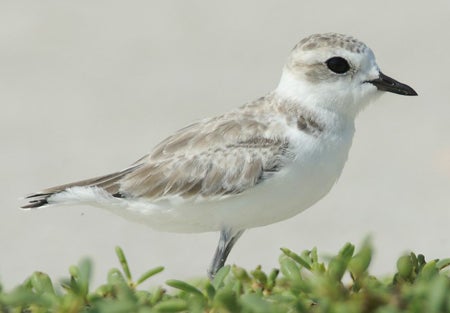SCIENTIFIC NAME:
Charadrius nivosus Linnaeus
OTHER NAMES:
Beach Plover, Snowy Ringed Plover, Kentish Plover (Page 1995).
STATUS:
Breeder. Uncommon to rare and local in all seasons in Gulf Coast region. HIGHEST CONSERVATION CONCERN.
DESCRIPTION:
A small (15.0-17.0 cm [5.9-6.7 in.]) shorebird characterized by a thin dark bill, grayish or blackish feet and legs, pale gray upperparts, and white underparts. Adults have black side and breast patches, a black crown contrasting with a white forehead, and a dark auricular area; black not as dark in females. Nonbreeding adults and juveniles lack dark markings of breeding adults. Calls include a soft whistled ku-wheet and low kru (Page 1995, Marchant 1986). Six subspecies recognized. Two, the Cuban snowy plover (C. a. tenuirostris) and the western snowy plover (C. a. nivosus), are found in North America; the Cuban snowy plover is a permanent resident in Alabama.
DISTRIBUTION:
Species found in Europe, Africa, Asia, and North and South America. The Cuban snowy plover breeds along the GulfCoast from southern Florida westward to the northern coast of the YucatanPeninsula. Also nests in the Bahamas, Cuba, Dominican Republic, Puerto Rico, Lesser Antilles, and islands off the north coast of Venezuela. Birds winter locally within their breeding distribution. The western snowy plover breeds inland in parts of central Kansas, Oklahoma, south into Texas, and west into southern New Mexico. Also found in northern Utah, eastern California, western Nevada, and along the PacificCoast from Washington south into Baja California. Others nest locally in Saskatchewan, Montana, Arizona, and central Mexico. Birds winter locally along the PacificCoast from Washington south into Mexico and into Ecuador (Page 1995).
HABITAT:
In the Southeast, along coastal sandy beaches, nesting and feeding in washover areas of low barrier islands and up to the primary dunes on coastal beaches. Inland populations can be found in sparsely vegetated to barren flats of saline or alkaline lakes and sand bars of rivers (Makarick et al. 1998, Page 1995).
FEEDING HABITS:
Feed on beaches, tidal flats, and along the waterline on a variety of invertebrates including small crustaceans, aquatic insects, marine worms, and mollusks (Imhof 1962). When foraging, as with other plovers, typically wait, identify prey, run, and then seize it.
LIFE HISTORY AND ECOLOGY:
Males establish territories and call to attract potential mates. During courtship activities males may construct several nest scrapes. In the Southeast, pair bonds may be established nearly two months before egg-laying. Male and female line nest with bits of debris. A typical clutch of three eggs laid, with two days normally passing between each subsequent egg. Incubation by both sexes typically begins when clutch is complete. Incubation period around 26 days, with precocial young leaving nest within a few hours of hatching. Young feed themselves from onset while following parent or parents; become independent around 30 days of age (Page 1995). Nesting begins in April in Alabama. In western North America, females often abandon mates and broods soon after hatching, but in the Southeast, pairs often stay together until young fly. Will renest if clutch destroyed, and multiple broods can be raised, but not necessarily with the same mate (Page 1995). Gulls, red foxes, raccoons, and feral cats are potential predators of nests and young.
BASIS FOR STATUS CLASSIFICATION:
Have declined throughout their distribution, and in 1995 there was an estimated breeding population of around 21,000 birds. In 1993, Pacific coast populations were listed as threatened by the U.S. Fish and Wildlife Service (Page 1995). There are an estimated 500 Cuban snowy plovers (Brown 2000). Partners In Flight (PIF) considers the snowy plover a species of extremely high priority because it occurs at a very low relative abundance, has very limited winter and breeding distributions, and threats to its breeding and nonbreeding grounds exist (PIF 2002). As with any taxon that depends on coastal beaches for survival, snowy plovers face ongoing pressure from beachfront development and recreational activities. In Alabama, few areas of undisturbed Gulf beachfront remain. Single pairs have nested at GulfState Park and the Bon Secour National Wildlife Refuge in BaldwinCounty and PelicanIsland in MobileCounty. Birds may nest elsewhere scattered along the coast on private lands, but numbers undoubtedly are low. A high count of 25 at SandIsland (PelicanIsland), Alabama, occurred in November 1968 (Imhof 1976).
Author:
Roger Clay







